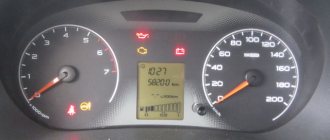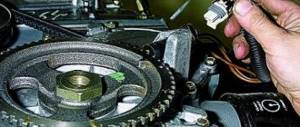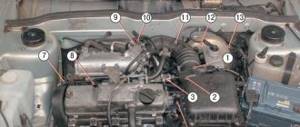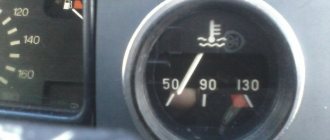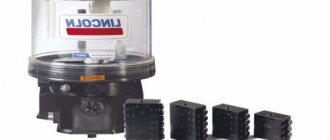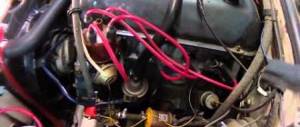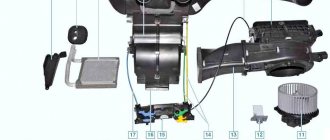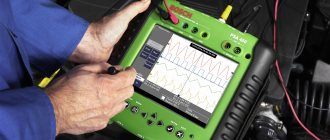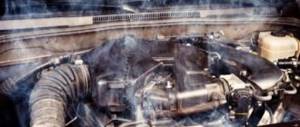06.11.2018
11269
Useful, Repair
The coolant temperature sensor (CTS) is not as simple as it might seem at first glance. Many people think that it is only responsible for turning the cooling fan on/off and displaying the coolant temperature on the dashboard. Therefore, if the engine malfunctions, they do not pay special attention to it. That is why I decided to write this article and talk about all the signs of a faulty DTOZH.
But first, a little explanation. There are two coolant temperature sensors (in some cases 3) - one gives a signal to the arrow on the dashboard, the second (2-pin) to the controller. Further we will talk only about the second sensor, which transmits information to the ECU.
And so, the first sign is poor engine starting when cold . How this happens is that the engine starts and immediately stalls. More or less works only with gas. After warming up this problem goes away. Why might this happen? The coolant temperature sensor may provide incorrect readings to the controller. For example, that the engine is already warmed up (temperature 90+ degrees). As you know, starting a cold engine requires more fuel than starting a hot one. And since the ECU “thinks” that the engine is hot, it gives it little fuel. This is what causes poor cold starting.
The second sign is poor engine starting when hot . Here everything is exactly the opposite. DTOZH may always submit underestimated readings, i.e. “tell” the controller that the engine is cold. This is normal for a cold start, but bad for a hot start. A hot engine will simply fill with gasoline. Here, by the way, error P0172 may appear - rich mixture. Check the spark plugs - they should be blackened.
The third sign is increased fuel consumption . This is a consequence that follows from the 2nd sign. If the engine is filled with gasoline, then consumption will naturally increase.
Fourth - random activation of the cooling fan . Those. The engine seems to be working normally, only sometimes the fan will turn on for no reason. This is already a direct sign of a malfunction of the coolant temperature sensor. The sensor may give erratic readings. Those. if the actual coolant temperature has increased by 1 degree, the sensor may “say” that it has increased by 4 degrees or may not react at all. So, if the temperature at which the fan turns on is 101 degrees, and the actual coolant temperature is 97 degrees (working), then, having jumped by 4 degrees, the sensor will “tell” the ECU that the temperature is already 101 degrees and it’s time to turn on the fan.
It’s worse if the opposite happens - the sensor can sometimes underestimate readings. The coolant temperature may already reach boiling point, and the sensor will “say” that the temperature is normal (for example, 95 degrees) and therefore the ECU will not turn on the fan. Thus, the fan may turn on when the engine is already boiling or may not turn on at all.
What is a coolant temperature sensor (CTS)?
Purpose
There are many sensors in a car. All of them control the operation of various systems of the car and its engine. If the sensors give incorrect readings, the performance of the vehicle is jeopardized. The same can be said about DTOZH.
DTOZH is designed to maintain stable operation of the internal combustion engine (hereinafter referred to as ICE). Due to DTOZH, the car warms up faster and reaches too high temperatures less often. Some people confuse the DTOZH with the coolant temperature gauge sensor. These are two completely different devices. The DTOZH provides its readings to the electronic engine control unit, and the second sensor notifies the driver about the temperature of the working fluid in the cooling system. The failure of the second sensor does not lead to serious consequences, unlike the first.
Speaking about DTOZH, we should also mention the purpose of the engine cooling system, since the operation of these two units is inextricably linked. Most often, a liquid cooling system is used, the main task of which is to remove heat from the engine. In addition, the system also has the functions of cooling the oil in the lubrication system, the air that circulates in the turbocharging system, exhaust gases, and the working fluid of the gearbox. It also has the function of heating air in ventilation and heating systems.
The operation of such an important car system directly depends on such a small detail as the DTOZH. Therefore, do not underestimate the sensor and neglect its diagnostics.
Design and principle of operation
The design of the DTOZH resembles a resistor. The design of the sensor provides for a change in its resistance to electric current when the ambient temperature fluctuates. These changes are recorded and used to issue commands to the internal combustion engine.
The predecessors of modern DTOZH were thermal relays. Thermal relays were installed in injection systems. When the contacts were in the open position, the engine became hot. If the contact closes, it means the engine has already warmed up enough (reached operating temperature). The design of modern DTOZH is based on a thermistor, which establishes the dependence of resistance on temperature. The thermistor is based on cobalt and nickel oxides. As the temperature rises, the number of free electrons in these substances increases, due to which the resistance drops.
Some thermistors in DTOZH are characterized by a negative temperature coefficient. In this case, the thermistor produces maximum readings when the engine is cold. A voltage of about 5 volts is supplied to the sensor. After this, as the power unit warms up, the resistance decreases. The engine electronic control unit (hereinafter referred to as ECU) monitors voltage changes and calculates the fluid temperature. After the engine warms up, the ECU begins to lean the fuel mixture. A malfunction of the DTOZH can also lead to an erroneous enrichment of the fuel mixture. The result of this will be increased atmospheric pollution and premature failure of candles.
If the engine speed at startup is insufficient, the engine may stall. A floating command from the ECU to increase the speed can prevent this. To maintain drivability while the engine is starting, the recirculation valve must be closed until the engine reaches its set operating temperature. Here, the result of a DTO malfunction will be floating engine speed. The engine may also stop. The ignition angle also depends on the functioning of the sensor, since this parameter is regulated by the system. The emission of harmful gases with this adjustment is significantly reduced. Ultimately, engine power and thrust, as well as the level of fuel consumption, directly depend on the operation of the DTOZH.
This is interesting: How to determine the exact size of a car's tires? Explanation of 5 markings
Thus, DTOZH is very important for the correct functioning of the car.
Sensor installation location
Where is the coolant temperature sensor located in a car? The location of the DTOZh installation differs for different models. Most often it is installed in the cylinder head near or on the thermostat housing. It is mandatory to locate the sensor near the outlet pipe through which the coolant flows back into the radiator. This arrangement is necessary for the accuracy of data transmission to the ECU.
Types of sensors
DTOZH are classified according to the principle of dependence on changes in resistance:
- DTOZH with negative temperature coefficient. The principle of operation of such sensors is that the internal resistance decreases as the temperature increases and vice versa.
- DTOZH with a positive temperature coefficient. The operating principle is the opposite of the previous type of sensors. In these sensors, the resistance increases as the temperature increases.
Currently, the first type of sensor is the most popular. Sometimes there are two sensors in a car: the main one and the additional one.
The main sensor performs the function of transmitting the temperature value to the computer, and the additional sensor turns on the fan.
Types of sensors
The coolant temperature sensor can be of two types:
- Mechanical;
- Digital.
A mechanical sensor is the simplest device that transmits parameters of changes in electrical resistance due to electrical signals. This sensor is connected to the temperature indicator on the car's dashboard, and this indicator is usually an odometer with an arrow and divisions in degrees. A relay works in conjunction with this unit, which, when closed, turns on the fans. Mechanical sensors are found on almost all carburetor cars.
This is interesting: Causes of internal combustion engine coking
A digital sensor is very similar in appearance and design to a mechanical one, only it sends signals not directly to the fan and dashboard, but to the electronic control unit. The ECU is equipped with a processor that, analyzing all incoming signals, issues commands to the cooling and ignition systems, and also displays temperature readings on the instrument panel.
There are also sensors:
- Magnetic;
- Bimetallic;
- Capillary (not used in modern cars).
DTOZH malfunctions and their symptoms
It is generally accepted that DTOZH is quite reliable due to its simple design. However, sooner or later, almost every component of the car is subject to wear and tear. In the case of DTOZH, there is a violation of the calibration. Such a violation leads to an unplanned change in resistance and incorrect operation of the ECU.
The most obvious sign of failure of the DTOZh is the failure of the fan to turn on when the temperature rises above the set values.
This indicator is not considered reliable if the car has both primary and secondary sensors. In this case, the malfunction will be more accurately indicated by oxidation of the wiring or failure of the additional sensor. The main signs of a DTOZ malfunction are as follows:
- a drop in engine speed or spontaneous stopping at idle;
- longer vehicle warm-up time;
- increased frequency of the engine going beyond the optimal temperature range during operation;
- increased fuel consumption;
- decreased driver control over the car;
- smoke from the exhaust pipe takes on a black tint;
- violation of engine stability.
In addition, detonation knocking in the engine is sometimes possible. Some older car models have a special controller. When the needle of this controller goes beyond the critical zone, the vehicle must be stopped immediately. In this case, sometimes there is also a malfunction of the DTOZH. And in more modern models, the on-board computer notifies drivers of engine overheating. But such a message does not always indicate a malfunction of the sensor. This often occurs due to wiring breakage and oxidation.
Proximity sensor in a smartphone - how to set it up?
In different operating systems and graphical shells, these parameters are most often located in the call settings. For example, if you open the typing window and click on the menu icon, you can immediately go to the necessary options:
In the case of Xiaomi (MIUI 10), open the list of system applications, select “Phone”, then go to the “Incoming calls” item and activate the switch:
We figured out how to turn it on. But what if it doesn’t work or functions incorrectly? Let's move on to the next chapter of the review.
Causes of malfunctions
DTOZh breakdown rarely bothers motorists due to its simple design. But there are still enough reasons for failure. The use of low-quality antifreeze and motor oil leads to the destruction of the surface of the DTOZH. The sensing element of the sensor may become covered with sediment in the form of crystals. The reason may also lie in a manufacturing defect. You should not buy DTOZH at flea markets and various cheap auto parts markets. DTOZH purchased on such a market will often not meet the declared parameters and the slightest damage will lead to sensor failure. An antifreeze leak can cause the gasket to wear out. A voltage surge in the on-board power supply and corrosion of contacts can also cause sensor failure.
Checking the functionality of the coolant temperature sensor
Required tools and equipment
For the procedure for checking, removing and replacing the sensor, you will need the following tools:
- key to 19;
- multimeter;
- a container into which you will drain the coolant (a regular bucket will do);
- electric kettle for heating water;
- thermometer;
- container for hot liquid (a glass or small bucket will do).
Check procedure
How to check the coolant temperature sensor? This process is short and does not require any special diagnostics at a car dealership.
Do not forget - in order for the sensor to correctly indicate the temperature of the coolant, it is necessary that the DTOZH be immersed in this liquid. To do this, it is necessary to regularly check the presence of refrigerant in the system. This check is the first step that should be taken if there is a suspicion of a malfunction of the DTOZH.
This is interesting: Where is it more profitable to buy a new car: prices for a Chevrolet Cruze station wagon
The next step is to check the contacts for oxidation and corrosion. It is also necessary to identify violations of the connection of the DTOZH to the system. After studying the vehicle's operating instructions, check the number and location of sensors. After this, find the DTOZH and establish that everything is in order with its connection. To do this, the DTOZH will have to be dismantled, since the test involves immersing it in a container for hot liquid.
Take the sensor and place it in a container of boiling water. Next, you need to measure the resistance at the output. In this case, sensors on different car models will show different values. Tables with optimal resistance for each model are available on the Internet.
If the indicators of the reference and measured values are different, then the DTOZH must be replaced. The design of the sensor is so simple that it does not require repairs.
How to check the coolant temperature sensor? It is necessary to lower it into heated water (as mentioned above). Then take a thermometer and place it in a container of cold water. It is recommended to use an electronic thermometer. Connect a multimeter to the sensor that is configured to measure resistance. Then lower the DTOZH into water and take measurements. Then the container with cold water is heated to 15, 20, 25 degrees, and the obtained measurement results are recorded. If the results do not coincide with the reference ones, replacement will be required.
There is a way to check DTOZH without a thermometer. The temperature of water at boiling reaches 100 degrees. This temperature is taken as a basis and the resistance is measured. When water boils, the resistance should be approximately 176.7 ohms. With errors, it can reach about 190 ohms. If the indicators do not match, the sensor will also need to be replaced.
As an example, below is a table showing the dependence of temperature on resistance.
| Temperature in degrees Celsius | Resistance (Ohm) |
| 5 000 — 6 500 | |
| 10 | 3 350 — 4 400 |
| 20 | 2 250 — 3 000 |
| 30 | 1 500 — 2 100 |
| 40 | 950 — 1400 |
| 50 | 700 — 950 |
| 60 | 540 — 675 |
| 70 | 400 — 500 |
| 80 | 275 — 375 |
| 90 | 200 — 290 |
| 100 | 150 — 225 |
How to check DTOZH
First of all, you need to remember that in order to correctly indicate the temperature of the coolant, the sensor must be immersed in this very liquid. Therefore, regularly check the presence of refrigerant and its level in the system. This is perhaps the very first thing that should be done if there is a suspicion of inadequate operation of this meter.
If the level of antifreeze in the cooling system is in perfect order, then the contacts may be oxidized or there are other irregularities in the connection of the coolant temperature sensor. You can check its connection yourself. Typically, but not always, this sensor is installed next to the thermostat. In some engines, there is more than one DTOZH. Therefore, check the number of sensors and their location, which are correct for your car. When you have found the coolant temperature sensor and determined that everything is in order with its connection, you need to check the device itself. To do this, the DTOZH must be dismantled, since it must be checked by immersion in a glass of boiling water.
And so, take your sensor, lower it into a glass of boiling water and measure the resistance at the output. In general, there are no uniform indicators of changes in resistance. Sensors for different machines, from different manufacturers, will show different resistance differences. The correct values at certain temperatures, specifically for your sensor, need to be found on the Internet.
Accordingly, if the sensor resistance readings and the reference values coincide or have a minimal error, then the coolant temperature sensor is in good working order. Well, if the resistance values differ, the sensor needs to be replaced. Actually, its design itself, as well as the principle of operation, do not provide for any repairs. Therefore, there are simply no other alternatives.
Replacing the coolant temperature sensor
Replacing the coolant temperature sensor is easy to do yourself. Before replacing, you must first drain the coolant into a prepared container. Next, the old sensor is dismantled. The DTOZH is screwed into a special threaded hole. Unscrew and remove it, and then install the new sensor in reverse order. Before installation work, check the vehicle's operating instructions for the exact location of the sensor.
After purchasing a new sensor, it is recommended to check it for defects using the methods described above. Before screwing the new sensor into the seat, it is recommended to treat the threads with sealant. After installing the new sensor, wiring is connected to it. Then the coolant in the system must be brought to normal. That is, liquid leakage is unacceptable. After making sure that they are absent, you can start the engine.
For what reason may a temperature sensor malfunction?
The design of the coolant temperature sensor is quite simple, so the sensors themselves break down very rarely, but various failures occur quite often. The reasons for the failures are:
- Use of low-quality antifreeze in the cooling system. Often, many drivers fill the cooling system with antifreeze from unknown manufacturers, and sometimes even “TOSOL”. The use of such liquids leads to the formation of deposits in the cooling system. When covered with this coating, the sensor material can change its structure and give incorrect signals. As a rule, the temperature begins to be recorded lower than in reality. As a result, the fans turn on late, and the engine runs for some time without proper cooling;
- Poor quality sensor. Many unconditionally believe the seller’s assurances that defects in such a simple part are in principle impossible and buy sensors from unknown Chinese manufacturers. Although the Chinese are masters at disguising cheap materials as more expensive ones by painting or spraying them. And handicraft production is not able to ensure the accuracy of part manufacturing. Such a sensor, if not activated in time, can easily lead to failure of the engine cooling radiator;
- Radiator leakage through a broken thread or a loose sensor. Do not forget that the radiator material is quite soft and you should not tighten it with excessive force. You should also not tighten it too much. Damage to the gasket can also lead to leakage;
- Electrical problems. This is the most common reason for the sensor to not work correctly. An error in operation can be caused by many factors, from sudden voltage surges to banal oxidation of contacts. Any sensor check must include steps to check the condition of the contacts;
- Unstable thermostat operation.
This is interesting: The principle of operation of internal combustion engines
Before replacing the coolant temperature sensor, you need to clearly determine the symptoms of the problem, whether the sensor itself is broken or there is an electrical problem. To do this, disconnect the sensor and check it with a conventional multimeter.
